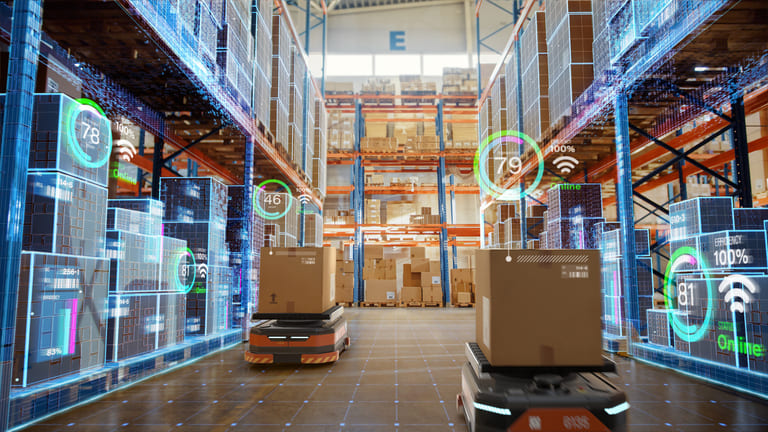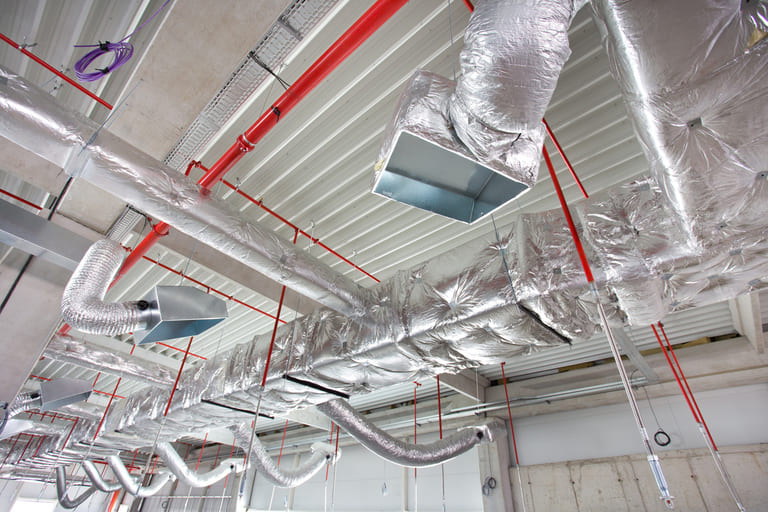

Taiyo Kogyo Column
What are the important fire codes for warehouses? From required firefighting equipment and inspections to the latest trends.
2025.05.02
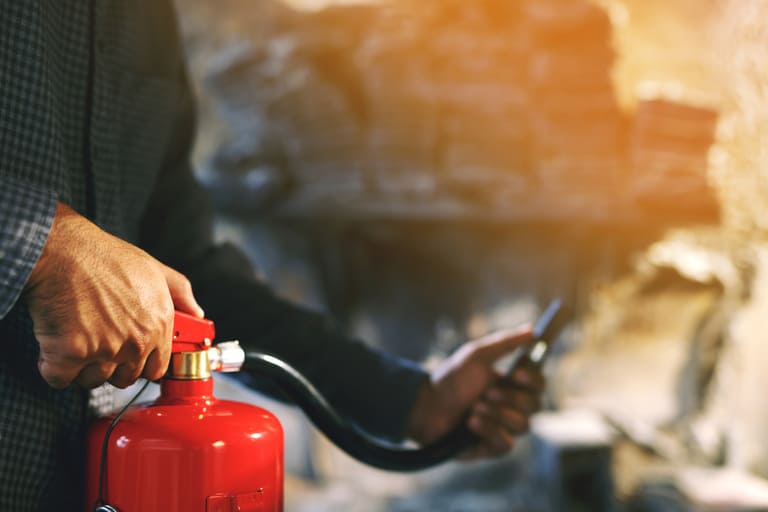
When building a new logistics warehouse, it is important to understand the obligation to install firefighting equipment in accordance with the Fire Defense Law.
Warehouse fires can cause extensive damage, so safety measures are essential. In addition to ensuring appropriate fire extinguishing equipment and evacuation routes, periodic inspections are also required.
This article details the necessary firefighting equipment, legal requirements, and the latest trends in fire prevention measures. Strengthen your disaster prevention measures and aim for safe warehouse operations.
>> Click here to visit our website specializing in “Tent Warehouses”.
Legal obligations to warehouses as defined by the Fire Code
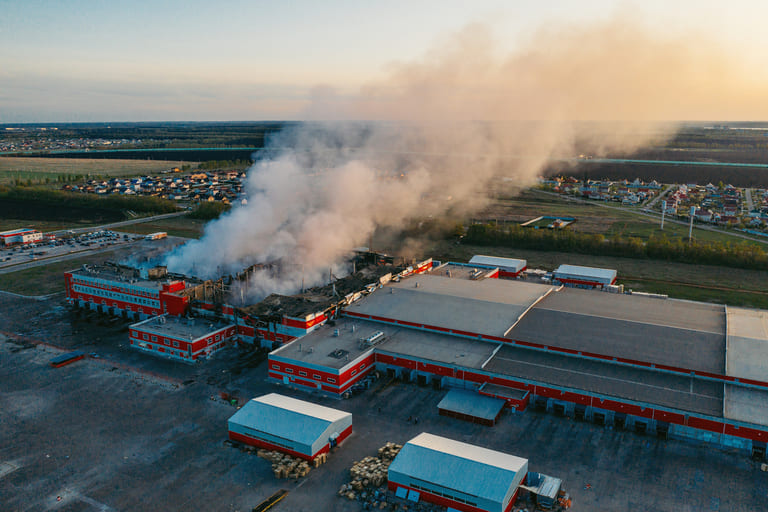
The Fire Service Law requires large warehouses and factories to install firefighting equipment to ensure safety in the event of a fire.
This measure is intended to address the unique risks inherent in warehouses. Warehouses have few openings, which may delay the detection of a fire, and they also have the characteristic of storing large quantities of goods.
These goods include highly flammable items and items that emit toxic gases, which can easily cause extensive damage in the event of a fire.
For this reason, the Fire Service Law requires that appropriate firefighting equipment be installed depending on the size and structure of the warehouse.
Wooden warehouses exceeding 700 m2 , fireproof warehouses exceeding 1,400 m2 , and fireproof warehouses with interior restrictions exceeding 2,100 m2 are required to install an indoor fire hydrant system.
In addition, an automatic fire alarm system must be installed if the total floor area exceeds 500 m2.
Furthermore, facilities with a ceiling height exceeding 10 m may be obligated to install sprinkler systems.
By properly maintaining these facilities, damage can be minimized in the event of a fire.
In addition, installed firefighting equipment must be properly maintained and managed, with periodic inspections and notifications required.
Compliance with these legal obligations will ensure the safety of facility users and stored materials and reduce management risks.
For more information on interior restrictions, please refer to the article “What are Interior Restrictions for Warehouses? From the types of fireproof materials to the risks of violations to avoid,” please see the article ” What Are Interior Restrictions for Warehouses?
Firefighting equipment required for warehouses
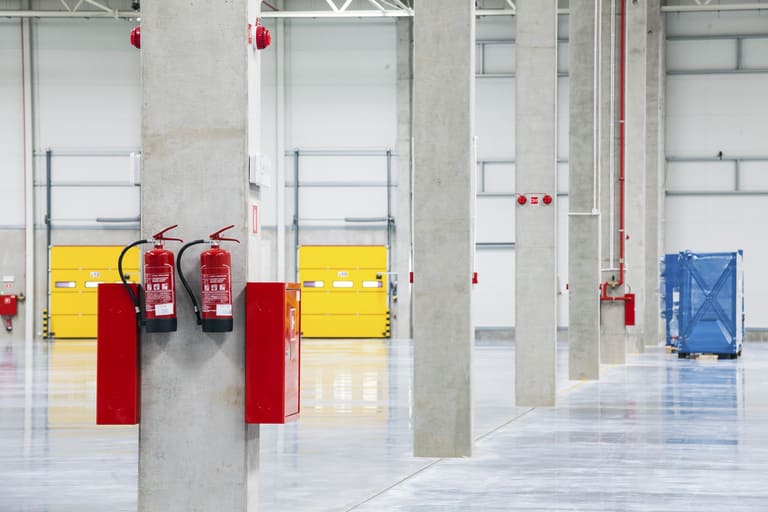
Under the Fire Service Law, equipment that must be installed in warehouses is classified into three categories: fire extinguishing equipment, alarm equipment, and evacuation equipment. The following is a detailed explanation.
fire extinguishing equipment
Fire extinguishing equipment is essential for initial response to a fire. Typical equipment includes fire extinguishers, hydrants, and sprinkler systems. Install appropriate equipment and maintain it thoroughly.
fire extinguisher
Installation of fire extinguishers is important to limit damage in the early stages of a fire in a warehouse.
The installation standard applies to warehouses with a total floor area of 150 m2 or more.
In addition, fire extinguishing equipment is required to be installed on basement floors, windowless floors, and floors above three, when the area exceeds 50 m2.
Note that a windowless floor is a ground floor of a building that has no openings for evacuation or firefighting. Appropriate equipment must be provided to minimize fire risk.
sprinkler system
Sprinkler systems automatically detect heat in the event of a fire and spray water from a head installed on the ceiling to extinguish the fire.
The system quickly detects a fire and automatically sprays water from above to extinguish the fire in its initial stages. This system is particularly effective as a disaster prevention measure in rack-type warehouses, and is effective in preventing the spread of fires.
The installation standards apply to warehouses with a ceiling height of more than 10 m and a total floor area of more than 700 m2, and in high-rise buildings, installation is mandatory on the 11th floor and above.
Indoor fire hydrant equipment
Indoor fire hydrant systems are important equipment installed to suppress fires that cannot be handled by fire extinguishers.
It mainly consists of a water source, pressurizer, activator, hydrant box, and emergency power supply. When a fire is extinguished, a hose from the hydrant box is removed and extended to release a large volume of water.
The installation obligation applies to buildings with a total floor area of 700 m2 or more, and to basements, non-windowed floors, and floors of 150 m2 or more above the fourth floor.
Outdoor fire hydrant equipment
Warehouses require a variety of fire-fighting equipment, of which outdoor fire hydrant systems play an important role.
Outdoor fire hydrant systems are installed primarily to prevent the spread of fire to adjacent buildings and are used to extinguish fires externally, especially in response to fires occurring on the first and second floors.
While similar in configuration to an indoor fire hydrant system, it has higher water pressure and water discharge, and has powerful firefighting capabilities that can handle both early and medium-term fires.
As for installation standards, buildings with a total floor area of 3,000 m2 or more for the first and second floors fall under this category.
Alarm equipment
Alarm systems are essential in warehouses for early detection and notification of fires. Some typical equipment is described below.
emergency warning system
Emergency alarm systems are indispensable for quickly notifying people of a fire.
This equipment sounds an alarm at the touch of a button or other means to communicate the occurrence of a fire to those concerned.
Emergency alarm devices include alarm bells, portable loudspeakers, and manual sirens, which are used to quickly alert people in the facility.
In particular, facilities with a large number of people are required to install them, and even facilities with a capacity of 20 to 50 people need to install emergency alarm devices.
Furthermore, in basements and windowless floors, broadcasting equipment is legally required to be installed to ensure that the occurrence of a fire is communicated. It is important that the equipment be placed in a conspicuous and readily operable location to facilitate prompt evacuation.
automatic fire alarm
Warehouses must be equipped to detect and alarm early in the event of a fire.
This includes automatic fire alarms that detect heat, smoke, and flames.
Alarms are notified by bells and sounds to quickly inform people inside the building. The standard for installation is a total floor area of at least 500 m2, but it is mandatory for basements, floors without windows, and floors above the third floor with a floor area of at least 300 m2.
In addition, it is mandatory on floors above the 11th floor. This will help minimize fire damage.
fire alarm or fire alarm system
Warehouses are required to respond quickly in the event of a fire, so a fire alarm system will be installed to automatically notify the fire department.
This device can be operated in the event of a fire to make a report or call using a telephone line.
The criteria for installation are warehouses with a total floor area of 1,000 m2 or more, but installation may not be required if certain requirements are met.
Leakage fire alarm
Leakage fire alarms are important devices that detect electrical leakage from electrical equipment and prevent fires.
Installation is required by law for facilities with a total floor area of 1,000 m2 or more. Install appropriate equipment and ensure safety management.
evacuation facilities
Warehouses must have evacuation equipment to ensure safety in the event of fire. Here, we will explain in detail about a typical facility, “guide signs (guide lights).
Guidance signs (guide lights)
In the event of a fire, evacuation routes should be equipped with emergency exit signs and guide lights to ensure safe movement.
According to the standards of the Fire Service Law, equipment must be installed in all buildings and on every floor.
In particular, evacuation guide lights are essential on basement floors, windowless floors, and high-rise floors.
This assists in rapid evacuation in the event of an emergency and prevents human casualties.
Latest Trends in Fire Fighting Equipment

In recent years, firefighting equipment has evolved greatly through technological innovation.
Fire prevention is becoming increasingly important, and new products are constantly being introduced.
One of the most notable developments is the spread of smart firefighting systems.
The system utilizes IoT technology, with a network of sensors and cameras.
Real-time monitoring is enabled, and the system immediately notifies the user in the event of a fire.
This allows for early detection of fires and rapid response to minimize damage.
Drones are also being utilized.
Its usefulness has been recognized in high-rise buildings and sites requiring extensive surveillance.
Drones equipped with thermal imaging cameras and heat sensors can quickly identify the location and progress of a fire.
This ensures the safety of firefighters while supporting effective firefighting activities.
Another important aspect is the evolution of firefighting robots.
These robots are capable of entering hazardous areas and extinguishing fires.
They are expected to be especially useful in high-risk environments such as chemical plants and nuclear power plants.
Equipped with automatic control technology and sophisticated sensors, the system can respond accurately and efficiently.
Periodic inspection of firefighting equipment
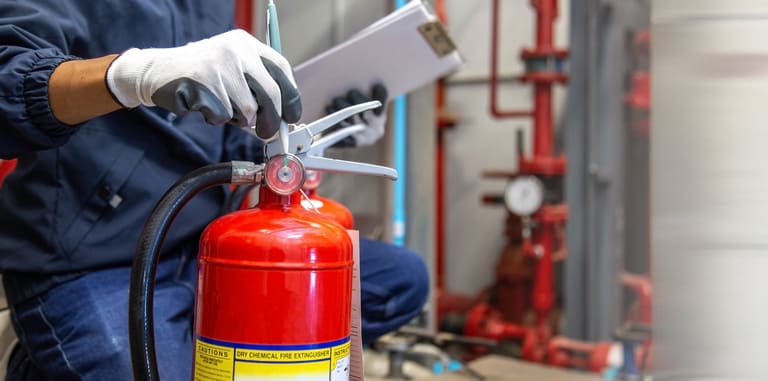
Firefighting equipment requires continuous management after installation, and periodic inspections are mandated under the Fire Service Law.
Inspections are divided into semi-annual equipment inspections and annual comprehensive inspections.
During the equipment inspection, equipment is checked for damage or deformation, and during the comprehensive inspection, equipment is actually put into operation to check its condition.
Inspection results are recorded in a maintenance ledger and used for management.
Although there is no obligation to submit records, proper management is important. The details to be checked during each inspection vary depending on the equipment.
Equipment inspection (once every six months)
As part of the regular inspection of firefighting equipment, semi-annual equipment inspections are important.
This is to ensure proper operation in the event of a fire. In addition to checking the appearance and location of the equipment, a detailed inspection is performed by operating each piece of equipment.
Inspect fire extinguishers carefully for damage to the unit and the condition of the indications and signs.
The appropriate installation position is also investigated visually and by simple measurement to confirm that the indicated pressure value is within the standard range.
For indoor fire hydrant facilities, carefully check the water reservoir, water supply system, water level gauge, and valves for damage or deformation.
In addition, the condition of the piping and nozzles is also checked to insure that they are in good working order.
In the case of sprinkler systems, we check the heads for damage or obstructions, and also inspect the operation of the detectors and the startup of the pressurized water supply system.
Performing these inspections will ensure proper operation and safety in the event of a fire.
Comprehensive inspection (once a year)
A comprehensive inspection of firefighting equipment is an annual inspection.
This is done in the form of actual operation to ensure that the equipment is functioning properly.
Inspection details vary for each facility.
For example, for an indoor fire hydrant system, the operation of the pressurized water supply system is checked to see if the water discharge volume and pressure meet the standards.
Sprinkler systems are similarly inspected to ensure that the equipment is operating properly and that water discharge performance is within specified limits.
For leakage current fire alarms, check that they are working properly and that the operating current value is within the range of +10% to -60%.
For emergency alarms, inspect that the sound pressure of bells and sirens is 90 dB or higher, as well as fire alarm indicators, acoustic devices, and speakers to ensure that they sound without problems.
These comprehensive inspections are essential procedures to ensure that firefighting equipment functions reliably in an emergency and to protect lives and property.
Triennial reporting requirement
Under Article 17 of the Fire Service Act, warehouses classified as “Non-Specified Fire Prevention Objects” are required to report the results of inspections of fire-fighting equipment to the Fire Department or the Chief of the Fire Department once every three years.
The scope of this inspection includes fire extinguishers, fire alarms, and evacuation guidance systems, which must be maintained in accordance with laws and regulations to maintain proper function.
In the unlikely event that the reporting obligation is neglected, a fine of up to 300,000 yen or detention may be imposed in accordance with Article 44 of the Fire Service Law.
Failure to fulfill legal compliance responsibilities also carries the risk of reduced business credibility and serious damage.
It is important to ensure proper management and adherence to legal obligations.
Fire Precautions in Warehouses
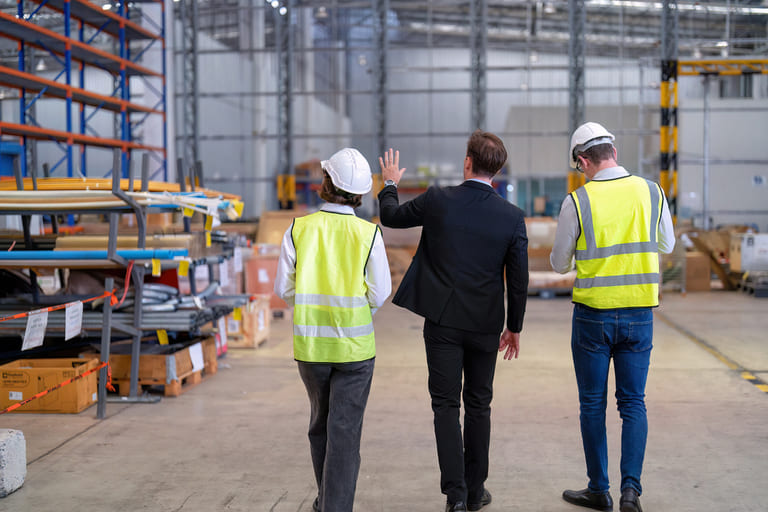
In addition to what we have told you so far, there are other things to keep in mind, and we will explain three points to keep in mind.
Strict regulations for hazardous materials warehouses
There are many types of warehouses and factories, but fire prevention is extremely important, especially for facilities that handle hazardous materials.
For this reason, more stringent regulations are set for hazardous materials warehouses in terms of building size, structure, and facilities.
For example, the floor area must be 1,000 m2 or less and the walls must be fireproof.
Furthermore, if the designated quantity is 10 times or more, lightning protection equipment must be installed.
In addition, there are detailed regulations regarding location and the types of hazardous materials that can be stored.
Therefore, when planning the construction of a hazardous materials warehouse, it is essential to fully consider these regulations and take appropriate action.
When inspection by a qualified person is required
Article 36, Paragraph 2 of the Fire Service Law Enforcement Order requires buildings that meet certain requirements to be inspected by a qualified person.
In the case of “non-specified fire protection objects” such as warehouses, if the total area is 1,000 m2 or more, they are subject to this inspection.
Non-specified fire protection objects are buildings that are not restricted to specific users.
Qualified persons who perform inspections include certified firefighting equipment operators or qualified fire equipment inspectors.
On the other hand, for buildings with a total floor area of less than 1,000 m2, it is possible for non-qualified persons to conduct inspections on their own, or to request a fire protection manager or other person to do so.
However, since the content of the inspection depends on the size and type of the building, it is important to make appropriate decisions.
Fire prevention manager required when there are 50 or more employees.
According to the Fire Service Law Enforcement Order, warehouses with 50 or more employees are required to have a fire prevention manager.
Capacity is calculated based on the number of employees, and specific criteria are established based on this number.
Fire prevention managers play an important role in fire prevention and are required to prepare and notify firefighting plans, conduct drills, and inspect and maintain equipment.
Proper implementation of these measures will minimize damage in the event of a disaster and ensure the safety of the warehouse.
summary
Compliance with fire codes in warehouses is essential for safe operations.
Warehouses, due to their structure, are prone to spreading damage in the event of a fire, and therefore require the installation and maintenance of appropriate firefighting equipment.
In addition to basic equipment such as fire extinguishers, sprinklers, and fire alarms, it is important to understand the equipment standards for the size and structure of the facility and to respond appropriately.
It also helps to avoid legal risks by keeping equipment functioning at all times through periodic inspections and checks by qualified personnel, and by fulfilling the reporting requirements of the Fire Service Law.
In recent years, the accuracy of fire protection measures has been improved by incorporating the latest technologies, such as IoT-based smart firefighting systems and drone surveillance.
Strengthen your warehouse’s disaster prevention measures and comply with laws and regulations to protect the safety of your employees and stored goods, as well as to achieve stable operations of your business.
The choice of construction method for the warehouse is also important for safe and efficient operation.
Many companies are introducing “tent warehouses.
Tent warehouses are constructed by assembling a steel frame and covering it with a sheet membrane, and can be built at low cost and in a short construction period.
It is also durable and weather resistant, and is so bright during the day that no lighting is needed, improving work efficiency.
A number of forward-thinking manufacturers and companies in the logistics industry have implemented tent warehouses.
Consider a tent warehouse as a means to achieve efficient warehouse operations.
If you are interested in the Tent Warehouse, please contact Taiyo Kogyo Corporation, a manufacturer that has been in business for 100 years and has the largest market share in Japan.
Tent Warehouseへの
Contact us

What you need to know when building a warehouse
We've packed it all in.
Clues to solving the 2024 problem
<
・Don't know where to start in building a warehouse
・Want to build a warehouse economically
・Want to know which type of warehouse to build
・Anyway, want to learn the basics of warehouse construction
・Worried about the 2024 problem, but don't know what to do
Related Articles
- TOP>
- Taiyo Kogyo Column>
- What are the important fire codes for warehouses? From required firefighting equipment and inspections to the latest trends.






